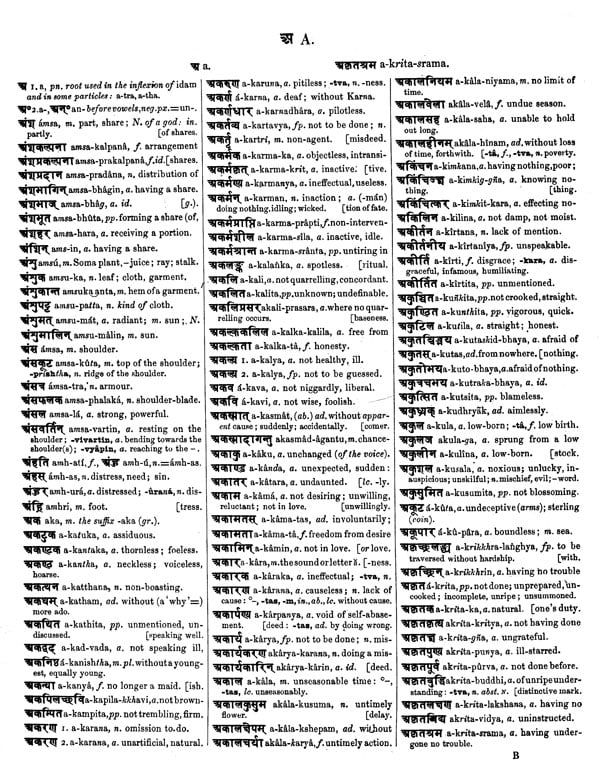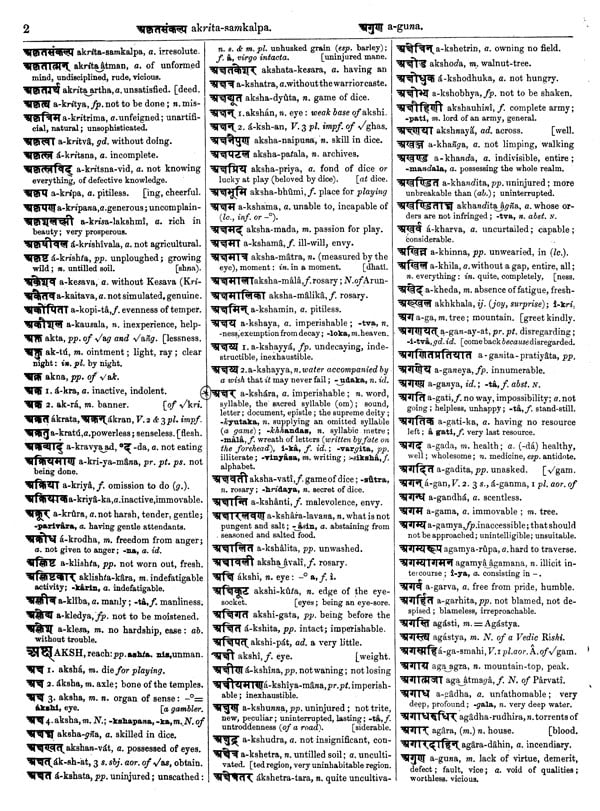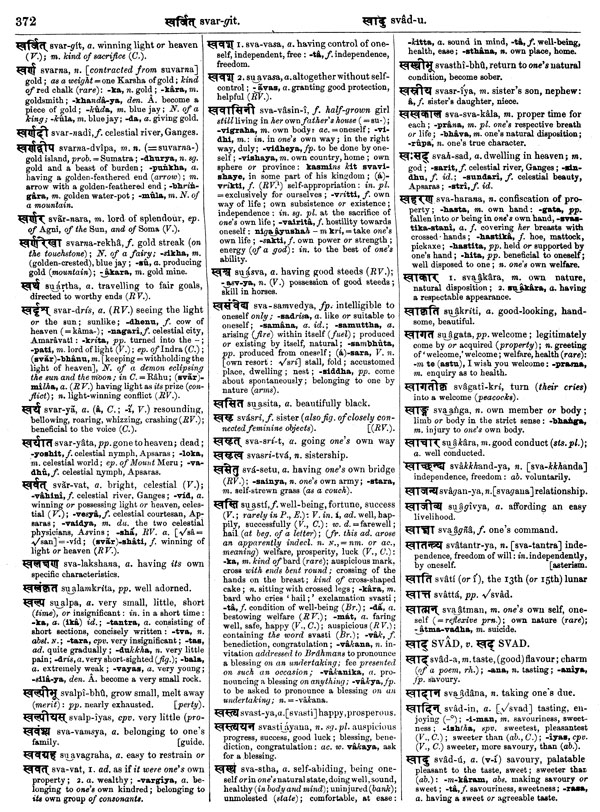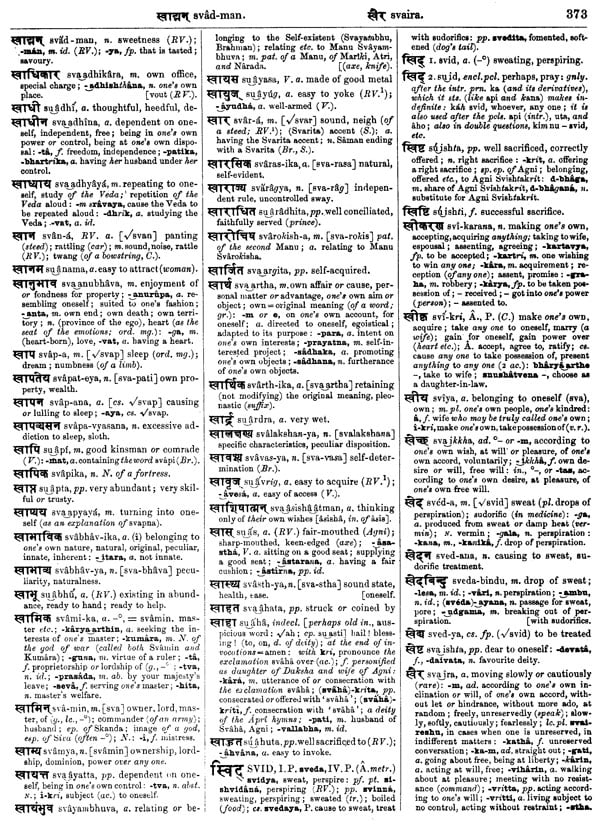
A Practical Sanskrit Dictionary
Book Specification
| Item Code: | NAZ448 |
| Author: | Arthur A. Macdonell |
| Publisher: | Bharatiya Granth Niketan |
| Language: | Sanskrit and English |
| Edition: | 2006 |
| ISBN: | 9788189211059 |
| Pages: | 384 |
| Cover: | HARDCOVER |
| Other Details | 12.00 X 9.00 inch |
| Weight | 1.13 kg |
Book Description
The aim of the present work is to satisfy, within the compass of a comparatively handy volume. all the practical wants not only of learners of Sanskrit, but also of scholars for purposes of ordinary reading.
Its distinctive features ought perhaps to be indicated here. It is, in the first place, much more copious than other lexicons for Sanskrit students. Excluding all words and meanings that occur in native lexicographers, but are not to be found in actual literature, this lexicon contains nearly double as much material as other Sanskrit works of the same character. This book is, moreover, the only one of its kind that is transliterated. It can thus be used, for example, by comparative philologists not knowing a single letter of the Devanagari alphabet. This is, further, the only similar Sanskrit dictionary that is etymological in any sense, for it gives a derivative analysis of all the words it contains. This feature increases both its usefulness from a linguistic point of view and its practical value to the student, who will always better remember the meaning of a word, the derivation of which is made clear to him. Lastly, this is the only lexicon of its type that indicates not only with respect to words, but also to their meanings, the literary period to which they belong and the frequency or rarity of their occurrence. This feature I regard as important to both scholar and student.
Scope of the Work. This Dictionary is intended to supply the vocabulary of the post-Vedic literature in general, but it also includes such selections of Vedic texts as are readily accessible to the student. All out-of-the-way technical terms, such as those of medicine, botany, astronomy, and ritual, are excluded, except in so far as they have found their way into ordinary literary works, or occur in selections which I have expressly"included. Specifically legal and philosophical terms are, on the other hand, rather fully represented, owing to the inclusion in my list of the most important works belonging to the corresponding departments of literature. A considerable number of grammatical and rhetorical terms have also been introduced, as these are necessary for the comprehension of commentaries like those of Mallinatha. A good many words and explanations will thus be found that either do not occur in the St. Petersburg dictionaries, or are, I think, less correctly defined there. (Cp. eg. the articles arthantaranyasa, bahuvrihi, yatha tatha, vakyabheda, vyadhikarana, sape- kshatva, &c )
Books specially referred to. The list of works to which the Dictionary is a vocabulary is the following :—Bhagavadgita, Bhartrthari, Bhashaparikkheda, Dasakumirakarita, Gitagovinda, Harsha- kavita, Hitopadesa, Kadambari, Kamandaktya-nitisira, Kathasaritsdgara, Kiratarguniya, Kullika, Kuméarasambhava, Mahavirakarita, Malatimadhava, Malavikagnimitra, Manu, Meghadita, Mitakshara (on Yagiavalkya), Mritkhakatika, Mudrarakshasa, Naishadha, Nala, Pa‘ikatantra, Raghuvamsa, Raga- taramgint, Ratnavali, Ritusamhara, Sakuntala, Samkara (on the Vedanta-sitras), Sisupalavadha, Tarkasamgraha, Uttarardmakarita, Vasavadatta, Vedantasara, Venisamhara, Vikramankadevakarita, Vikramorvasi, Yagiavalkya. Included is also Bohtlingk’s anthology of aphoristic poetry entitled Indische Spriiche (2nd ed.).
To represent the Brahmana period I have chosen the Aitareya-Brahmamna, and from the Sftras the Dharma-sfitra of Gautama and the Grihya-sitras of Asvalayana and Paraskara. I have also included all the Vedic matter contained in the Readers of Lanman, Béhtlingk (2nd ed.), Hillebrandt, and Windisch. Important Vedic words, even though not occurring in the selections, have found a place in this Dictionary mainly on linguistic grounds.
Arrangement. Both simple words and compounds, if they form a separate article, are printed in Devanagari as well as Roman type. But when there is a group of compounds in which two or more words are combined with the same prior member, the latter only is printed in Devanagart, while only the second member of the following compounds is given in transliteration (ep. e g. the article amrita). When the number of such compounds is large, they have been split up into several groups with reference to the initial of the second member (ep. p. 173). This,plan results in a great saving of space as well as in the practical advantage of enabling a word to be found more quickly.
As to the arrangement of individual articles, the transliteration of the Devanagari word is followed, in the case of nouns, by the derivation (in brackets) where this cannot be made sufficiently ‘clear by the employment of hyphens ‘in the transliteration (ep. € 9. bhoigu, muhirta, loka). Next gollow the meanings in close juxtaposition, so that the eye may take them all in at a glance if possible.. The senses of all words are intended to be given in the historical order of development. ‘Then come the special uses of the cases, and last of all idiomatic phrases (cp. buddhi, manas). When cases are mentioned they are given in the order of Sanskrit grammar. The feminine form of adjectives is stated in parentheses immediately after ‘w.’: thus ‘paurusha, a, (i)’» When no feminine is specified, it must be assumed to be 4 or else unknown.
Adjective compounds ending in participles are described as participles, e.g. su-gata, srotra-peya. This enables me to make an important distinction in sense without giving a long explanation. Thus suki-smita is described as an adjective because smita is here really a noun at the end of a Bahuvrihi compound. Again. any .confusion in the mind of the beginner between secondary adjectives like samajigan-iya and future participles like bodhantya is by this means avoided.
Figures have only been used either to distinguish words that have the same form but differ etymologically (as verbs like ruh or nouns like sam-udra and sa-mudra), or to mark off clearly groups of meaning (as under darsana).
Unnecessary repetition has often been avoided by the use of parentheses. Thus when samihita- mati is defined as ‘(having an) attentive (mind)’ the meaning intended 1s, that its equivalent is strictly speaking ‘having an attentive mind’, though it may ordinarily be rendered by ‘attentive’. The same object is attained by the use of dashes, implying that an obvious word or words are to be supplied from what precedes or follows. Thus sat-kirti is defined as ‘f. good reputation ; a. having a -’, which of course must be understood to mean ‘having a good reputation’ (cp. also dirgha-sattra, patana, vidhatavya).
Nouns have been given in their weak or middle stems, mainly because these are the forms to which suffixes and the second members of compounds are attached. Verbal roots have similarly been given in their weak forms with a view to uniformity; though I have ‘probably not been absolutely consistent in this respect! I think I have been sufficiently so for practical purposes.
I have sometimes yielded to practical exigencies in admitting such suffixes as -t& and -maya in long articles made up of compounds (ep under mitra). This can hardly do any harm ; for not even a tiro would be likely to confound such suffixes with regular words. :
Under important proper names I have generally added a few remarks together with approximate dates as far as these can be determined in the light of the most recent research (ep. e.g. Bhavabhita).
As definitions of technical terms are sometimes almost unintelligible without illustrative examples, the latter have been added where it seemed necessary (cp. e.g. samasokti).
In articles dealing with verbs, the conjugational class is first stated together with the voice in which it is inflected. When the latter is omitted, the verb must be understood to be both active and middle. Next come the present base or bases in transliteration, followed by the meanings of the verb arranged on the same principle as in the case of nouns, the idiomatic uses being stated at the end. After this are added the present passive (generally omitted) with the past passive participle ; then’the causative, the desiderative, and the intensive (when these occur) and their respective past passive participles.
The past passive participle, however, where adjectival senses predominate, has been given as a separate article in its alphabetical order. At the end of the articles dealing with verbs are arranged alphabetically the verbal prepositions. A scientific as well as a practical consideration determined me to concentrate them in this manner. On the one hand, these prefixes are separable in the Veda, while, on the other, a large amount of space is saved by making a single article of a verbal root and the prepositions with which it may be combined.
Exclusion of References. It is only when the meaning of a word is unknown in a passage or where the definition is made clearer by the reference, as in the case of samudga or sarvatobhadra, that a particular passage is specified. But I have endeavoured to aid the student in, finding the meaning appropriate to the passage, by limiting a word as far as possible to parallel instances, by indicating the case which it governs, by adding the context word, the literary period or departinent to which it belongs, and the frequency or rarity of its occurrence. Such articles as lohita or 72. ruh will illustrate my meaning.
Alphabetical Order. From this order (see p. x) I have never deviated, with one very slight and rare exception. I have sometimes transposed the order of two words, either to obviate breaking’ up a paragraph or to avoid repeating a definition (¢.g. smarya). The words being in immediate juxta- position, neither of them can be missed.
Under this head a few remarks should be added, in order to remove some common stumbling- blocks from the path of the beginner. Owing to variety of spelling, especially in Indian editions, words with initial and Ws may not be found under those letters. They will be discovered by looking up as respectively. The reverse also applies. The alphabetical position of Anusvara followed by a semivowel or sibilant is before . Thus Wat samvara and ara samsaya precede saka. On the other hand, the Anusvara which occurs before a mute of one of the five classes and is interchangeable with the nasal of that class, occupies the place of the class nasal. Thus immediately follows ayy sa-ghrina. Similarly, the unchangeable or necessary Visarga (i.e. preceding a hard guttural or labial) comes after a vowel before any other consonant. Thus WATT antah-karana and Wage antah-pura follow Wt anta and precede Wt&% anta-ka. On the other hand, the Visarga that precedes a sibilant, and may be assimilated to it, is treated as if it were that sibilant and placed accordingly. Thus Woy adah-saya and wu wifat adhah-sayin follow WAACY adhas-karana and precede Wa adhas.
Abbreviations. A full list of these explained will be found on p. x. A few explanations should, however, here be added showing how some of these symbols are applicable. When a sign such as V;. (= Vedic) is added in parentheses after a form, a grammatical symbol, or a meaning, its application is restricted to these only. Thus under / yam, ‘yéma means-that that present base is exclusively Vedic; when ‘sAd-as, x.’ is defined as ‘seat, place, abode, dwelling the meaning is that all these synonymous senses are Vedic. The application of such notes as ‘ord. mg.’ (= ordinary meaning) is similar. Thus under 1. mana, all the preceding words separated by commas, viz. ‘respect, regard, honour, mark of honour’ are indicated as included in the ordinary meaning of mana (ep. Punctuation). If, on the other hand, a symbol followed by a colon is used before a meaning, its application is carried on till another symbol oceurs. For example, under vriddhi the sense ‘ growth’ is indicated to be both Vedic and classical, ‘ delectation, delight’, Vedic, but all the significations from ‘adolescence’ onwards post-Vedic only.
Type. The small Devandgari is used for all articles except the verbs, for which the large type is reserved, Ordinary Roman type is employed for transliteration immediately after a word in Devanagari; but when a word occurs in transliteration only, it is printed in thick type so as to catch the eye at once (cp. e.g. akshara). When there is no object in attracting attention, as for instance when Sanskrit words occur in definitions or explanations, they are not made conspicuous in this manner.
To the special use made of the italic type, I attach considerable practical value. Its occurrence in definitions always implies amplification or elucidation, whereas the ordinary Roman type represents as far as is possible the exact literal equivalent of the Sanskrit word. Thus sanvarana-srag is defined as ‘wreath given by u girl to the man of her choice’ (cp. also samana_upama). By this means needless repetitions and waste of space are avoided, while much is gained in clearness of definition at the same time.
Punctuation. The colon immediately before a transliterated word or suffix, indicates that the latter must be attached to the end of the preceding Sanskrit word. Thus :-ka after the heading word loshté4 is to be read as loshta-ka. This is in no way affected by the intervening special uses of cases or idioms often added at the end of ‘an article. Thus: -kesarin under vi-krama must of course be understood as vikrama-kesarin, in spite of the inflected forms of vikrama which immediately precede -kesarin. The special significance of the semicolon is, besides marking off distinctly different meanings, to separate within a paregraph the words that form the latter members of the compounds which it contains. Thus ;-kakshus under lola-karna, is to be read as lola-kakshus, and the following --ta as lola-ta. Had the latter been preceded by a colon, the result would have been lola-kakshus-ta. The semicolon will sometimes be found instead of the colon when it is per-ectly obvious that nothing else could be done with the following word but attach it to the end of the preceding one. This is e. g- the case with ;-k&ra after the heading word loha. The comma is employed specifically, besides separating more or less synonymous meanings, to show, in paragraphs containing compounds, that the following word is to be applied exactly in the same way as a preceding one introduced by a colon. Thus ‘sat-karya followed by :-v4da, and subsequently by ,-vadin, must be read as satkérya-vada and satkarya-vadin.
Transliteration. The system here followed is that which has been adopted in the ‘Sacred Books of the East’. Its distinctive feature is the use of italics to represent the palatal and the cerebral classes of consonants, which appear as k kh g gh i and tthddhn. The equivalents of these two groups, according to a system commonly used at the present time, are:—c ch j jh f and t thd dh n. Care should be taken by the student to avoid pronouncing the palatals like gutturals. Thus sandra, = chandra, gaya =jaya.
When one or more letters representing suffixes, in thick type are added (without a hyphen) after a Sanskrit word, either in parentheses or following a semicolon, colon, or comma, the meaning is that that letter or those letters are to be substituted for precisely the same number at the end of the word in question. Thus ‘ paurusha, a. (i) ’, ‘yamaka, «. (ika) signify that the feminine of the former adjective is paurushi and that of the latter yamikaé. Similarly ‘samana-mirdhan, a. (nf)’ indicates that this word has the form samana-mardhni in the feminine. The letters :i-ka, referring to a preceding paurana, must be read with that word as paurani-ka.
Accent. Wherever the accent is known from Vedic.texts it has been given in the transliteration, the Udatta (acute)'accent being marked in the usual way (e.g. vidhar) and the svarita (circumflex) accent being indicated by a curve above the vowel (e. g. svar).
When an accented word is exclusively. Vedic, this is indicated by a V., while if nothing is stated, it may be assumed to be post-Vedje also (e. g. vina). As the meanings of an accented word may be partly Vedic, partly post-Vediec, and partly common to both periods, this is broadly indicated by the symbols V. (= Vedic in general), C. (= post-Vedie in general), and V.C. (= both Vedic and post- Vedic), as e.g. in the article vraté. Unaccented words may be assumed to be post-Vedice, since in the rare cases when they happen to belong to the Vedic period, this is noted. Sometimes I distinguish subordinate periods, as Br. = Brahmana, S. = Sutra, HE. = Epic, P. = Purana, It would, however, have been beyond the scope of the present work to go into details of this kind. I may mention in passing that. drag Aeydueva are indicated, a single occurrence in the Rigveda, for instance, being inarked as RV.!, just as words and meanings quotable only from native grammarians and lexicographers are made recognizable by an asterisk. ‘These are important safeguards; for the signification of the former class of words is often very doubtful, while the genuineness of the latter is uncertain. I have frequently seen non-quotable words, without any indication that they were such, used: by comparative philologists, as well as drag Aeydpeva made the bases of far-reaching conclusions. Thus I remember many years ago hearing an Oriental scholar, who was not a Sanskritist, using as an argument for Babylonian influence the word mana, to which the older St. Petersburg dictionary in ofe sinyle passage attributed the meaning of ‘a certain weight of gold’, and which, was therefore supposed to be identical with the Greek pva@. This unique meaning has disappeared from the later edition of the lexicon. Compounds arranged under an accented heading word, must be assumed to be unaccented and therefore post-Vedic unless any indication to the contrary is given. Thus -ketu, under viyayd4 is to be read as vigaya-ketu. It follows as a matter of course that, if the second half of & compound has an accent, that is the accent of the whole word.: Tlius -maya occurring under loh& represents loha-imaya.
Etymology. Though not comparative, this Dictionary is historical and etymological in its character. It is historical inasmuch as the meanings are not given in an arbitrary order, as in the Indian ‘dictionaries, while the literary period to which both words and their senses belong; is plenti- fully indicated. It 1s etymological from the Sanskrit point of view inasmuch as all words, except the small number—far smaller than in any other Aryan language—which defy analysis, have been broken up into their component parts, in the transliteration, by means of hyphens, as in yag-iva, or of hooks where vowel coalescences occur, as in mrigajkshana for mrigekshana. Where these means are insufficient, the derivation has been concisely added in brackets, as under /mirkh, yaksha, radhi. I have inserted in brackets a not inconsiderable number of roots, the former existence of ‘which, though no longer occurring as actual verbs, is deducible from Sanskrit derivatives alone, or is proved by the evidence of comparative philology also (e.g. /maiig, "1.rudh), The structure of Sanskrit words being so much clearer than that in any other Aryan tongue, I have thus availed myself of the opportunity of supplying students of the language with an easy instrument of linguistic training.
Sources. The present. work derives its material mainly from the shorter St. Petersburg Dictionary (1879-83) in combination with Bohtlingk and Roth's older Dictionary (7 vols., 1852-75). The production of the latter work is no doubt the most important event in the history of Sanskrit research. The rapid strides made by Sanskrit studies during the last sixty years are chiefly due to the lexicographical labours of those two great scholars. It was a fortunate combination of circum- stances that the task was undertaken in an age when strictly scientific methods had begun to be applied to scholarship and that the work fell into the hands of two scholars of such eminent ability. The result has been that Sanskrit lexicography, not having had to clear away the unscientific accumulations of previous centuries, at once reached a more advanced state than that of the classical languages. I have also used throughout Grassman’s Lexicon to the Rigveda, as well as a copy of Benfey’s Sanskrit Dictionary annotated by the author himself. Apte’s Sanskrit-English Dictionary and Cappeller’s Wérterbuch have to some extent been utilized.
I have further consulted Whitney’s Sanskrit Roots, the glossaries contained in the Readers of Lanman, Hillebrandt, and Windisch, as well as in Johnson’s Hitopadesa, Kellner’s and Monier- Williains’s Nala, Stenzler’s and Johnson’s Meghaditr and Burkhart’s Sakuntala, besides the Index to Pischel and Geldner’s Vedische Studien, various articles in the Journal] of the German Oriental Society and Kuhn's Zeitschrift, and Prof. Bihler’s lexicographical notes in the. Vienna Oriental Journal. Finally, this work contains numerous compounds and meanings collected by myself from post-Vedie works, such as the Pafkatantra.
The list of Corrigenda (pp. xi-xii) contains several corrections (mostly misprints due to the omission of accents or diacritical marks) which I owe to the kindness of Prof. C. Cappeller of Jena. Being himself a lexicographer, he has detected errors that would probably have escaped the notice of most other scholars.
Book's Contents and Sample Pages









